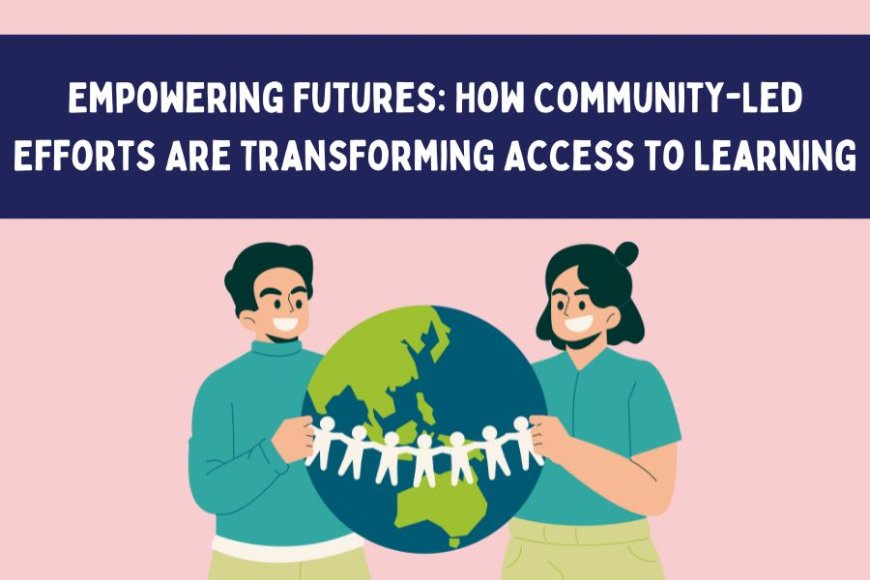Empowering Futures: How Community-Led Efforts Are Transforming Access to Learning

Education remains the most powerful tool in shaping the future of any nation. While policies and reforms are essential, the backbone of real change lies in ground-level community-driven initiatives. Across India, especially in urban and semi-urban regions, a silent revolution is underway. Local leaders, volunteers, and citizens are collaborating to address the most fundamental gaps in access to quality learning.
These efforts go far beyond building schools—they are about building confidence, opportunity, and long-term sustainability in young lives.
Why Grassroots Educational Movements Matter
Despite India's progress in literacy rates over the last few decades, millions of children still lack access to quality education. This gap widens in underserved communities, where infrastructure is poor, teacher-student ratios are inadequate, and dropout rates are high.
What makes community-led initiatives distinct is their contextual understanding of local challenges. While national schemes often take a one-size-fits-all approach, local programs adapt to specific cultural, social, and economic realities.
Unique Characteristics of Community-Based Education Projects:
-
Localized Curricula: Tailored to community needs—focusing on literacy, numeracy, health education, and life skills.
-
Volunteer Engagement: Empowering retired professionals, college students, and homemakers to teach and mentor.
-
Flexible Timings: Accommodating children who work during the day or manage household responsibilities.
-
Holistic Support: Often includes meal programs, healthcare tie-ups, and vocational training.
Delhi’s Urban Landscape and Education Disparity
Delhi, being a major metropolitan city, presents a paradox. On one hand, it boasts some of India’s best schools. On the other, thousands of children in slums and unauthorized colonies grow up without access to basic education.
In this context, the role of an Education NGO in Delhi becomes immensely important. Such organizations bridge the educational divide by offering tuition support, enrolling out-of-school children, and creating safe learning spaces. Many of them work closely with the local government, running community learning centers, digital literacy programs, and even night schools for working children.
Digital Literacy and the New Education Narrative
With the proliferation of smartphones and internet access, the definition of "basic education" is rapidly evolving. Today, knowing how to operate a computer or navigate a smartphone is just as critical as reading and writing.
Digital initiatives in education include:
-
Online Classrooms: Especially beneficial for children in remote or unsafe areas.
-
E-Libraries: Giving access to hundreds of books and videos.
-
Teacher Training Modules: Helping community educators stay updated on modern pedagogical techniques.
-
Gamified Learning Apps: Making education interactive and fun.
Digital inclusion, however, comes with its own set of challenges such as language barriers, connectivity issues, and lack of parental support at home. That’s where community facilitators step in.
The Gender Divide: Barriers Girls Still Face
India has made noticeable progress in female literacy, but significant challenges remain—particularly in rural and underprivileged areas. Cultural norms, early marriage, safety concerns, and household duties often stand in the way of girls attending school consistently.
The effort to strengthen education for girls in India isn’t just a campaign—it’s a critical step toward equitable nation-building. Numerous organizations focus exclusively on empowering young girls by not only enrolling them in school but also ensuring they stay and succeed.
How Education Empowers Girls:
| Benefit | Impact |
|---|---|
| Delayed Marriage | Girls with secondary education are six times less likely to marry before 18. |
| Economic Growth | Educated girls are more likely to join the workforce and uplift their communities. |
| Improved Health Outcomes | They make informed choices about nutrition, hygiene, and family planning. |
| Civic Participation | Education fosters leadership, decision-making, and community involvement. |
Key Focus Areas for Gender-Inclusive Education:
-
Sanitary hygiene awareness and facilities in schools
-
Safe transportation or walkable distance to school
-
Scholarships and school supplies to reduce financial burden
-
Role models and mentorship programs
Holistic Approaches to Learning
True education is not just about textbooks and exams—it’s about life preparedness. Many community initiatives aim to equip children with practical skills that will serve them throughout life.
Common Non-Academic Modules Offered:
-
Financial Literacy: Basics of budgeting and saving.
-
Health and Hygiene: Nutrition, first aid, and mental wellness.
-
Arts and Sports: Expression and teamwork skills.
-
Vocational Training: Especially for teens—tailoring, coding, carpentry, or digital marketing.
Community Participation: A Model That Works
One of the strongest aspects of successful grassroots initiatives is community ownership. Parents, elders, and local influencers play a vital role in keeping children enrolled, ensuring daily attendance, and tracking progress.
Ways Communities Contribute:
-
Monitoring & Feedback: Local committees assess quality of teaching.
-
Incentives: Communities celebrate high-performing students to boost morale.
-
Parent Workshops: Building awareness about the long-term benefits of education.
Such involvement strengthens trust and keeps the system accountable.
Policy Meets Practice: The Power of Collaboration
Although community efforts are impactful, their scalability depends on collaboration with state-run programs and private institutions. Several NGOs and local projects have partnered with CSR initiatives, universities, and tech companies to expand their reach.
When policy and practice meet halfway, the outcomes are sustainable.
Final Thoughts: Building a Learning-First Nation
Transforming education in India requires more than policy documents—it demands on-the-ground involvement, cultural sensitivity, and sustained commitment. Every child educated is a life empowered, and every life empowered contributes to a more resilient, inclusive society.
The efforts of local communities, driven by empathy and resourcefulness, prove that you don’t always need large budgets to make a difference. Sometimes, all it takes is a group of dedicated people who believe in the power of change.
Thank you for reading and understanding the heart behind this transformation.
Let us continue to support, volunteer, and advocate for grassroots education movements—because the future of India depends not just on how many children go to school, but on how many children stay, learn, and thrive there.



























































































































































